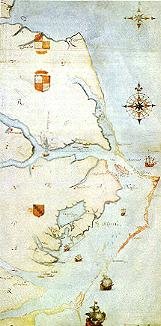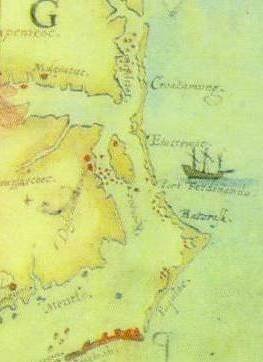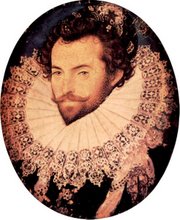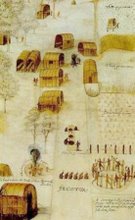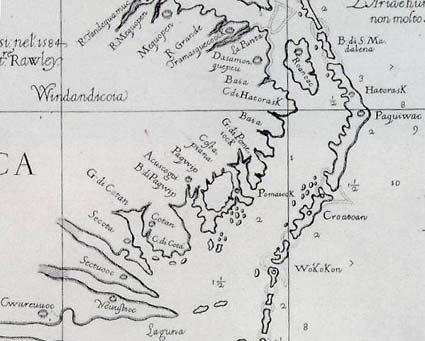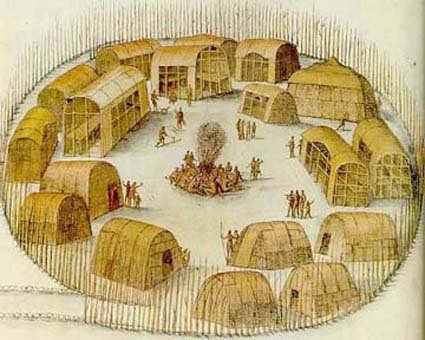Melungeon Myth of Drake Dropping off Passengers on Roanoke
By Janet Lewis Crain
A myth exists on the Internet that the Melungeons, a group of dark skinned
persons of mysterious origins found living in East Tennessee two hundred
years ago descend from Turkish prisoners and sundry other non-English persons
said to have been rescued by Sir Francis Drake during the sacking of Cartagena and
then deserted on Roanoke Island in 1586. In truth, there is NO evidence there
were any left behind there, much less several hundred. This myth was introduced
in a book published in the 1990's by Brent Kennedy titled The Melungeons:
The Resurrection of a Proud People : An Untold Story of Ethnic Cleansing in
America.
This book might have lanquished in obscurity on the shelves of a few Libraries
and book stores had it not been for the Internet and the new found surge
of interest in genealogy. Suddenly everyone fancied him or herself a Melungeon.
Several Unions were held of people from various mailing lists and persons attending
were happily discovering knots.on the back of their head, thought to indicate
Turkish ancestry. Having someone in your Family tree who possessed six
fingers was a definite plus. These traits were all described in the afore mentioned book.
No one ever looked too closely into the incident said to have occurred in 1586. But
that is precisely what this paper intends to do.
In the sixteenth century, Sir Francis Drake was one of the most famous men in England, indeed the English speaking world and beyond. He could do no wrong in his Queen's eyes. He had brought her an enormous return on her personal investment in an earlier voyage. A brilliant man in many ways, Drake was ruthless, but highly admired by the captives he had freed and the Maroons who came to his aid to help him fight and share in the rewards.
Drake was returning home from the sacking of Cartagena when he decided to
visit Roanoke and dispose of some of the freed prisoners and Maroons he had
acquired during his adventures. He was carrying a human cargo of some several hundred. Ivor Noel Hume in "Virginia Adventures" contends Drake
highly inflated the numbers. The voyage had not been financially successful
in spite of his daring and flamboyant actions. It is quite likely he was
advancing his case by sending back reports of greater exploits than actually
had occurred. There were reports of many nationalities released from the
Spanish prisons as well as Maroons who had come in from their strongholds in
the surrounding areas to help Drake as he was known to be generous with the
spoils of his marauding. Alas this voyage would not compare to previous ones.
This voyage is of great interest to Melungeon researchers because this
voyage in 1586 is the basis of the Turkish connection first started by
statements in Brent Kennedy's book: Melungeons; an Untold Story of Ethnic
Cleansing. It is, in fact, the keystone of the Turkish Connection Theory.
Remove it and the rest crumbles. That is what I propose to do.
It is known that many of the people with him never reached Roanoke. Many died of
strange fevers in Florida. These fevers were the scourge of sea travel at
that time. Caused in part by the crowding together of humans in the cargo
holds of ships where the fetid air trapped and spread any contagious
disease like wildfire, and probably acerbated by nutritional deficiencies.
In any case, reports contend that anywhere between 350 and 750 people died of
these fevers. Apparently Drake intended to leave the rest of the freed
Africans and South American Indians to furnish labor for the new Colony on
Roanoke which he expected to have grown to some 600 English by then. In
truth There were only about 100 men, badly in need of food and suffering the
ill effects of their bad treatment of the local Indians. Ralph Lane was in
charge at Roanoke and he accepted Drake's offer of minimal food supplies
(Drake had been out a long time and was running low himself) and a ship, the
Francis, capable of navigation into the bay plus other pinnaces, etc. and
armament. All the supplies were loaded onto the Francis along with Lane's
best naval officers. Lane wanted to stay a few more weeks exploring the
Chesapeake.
Hume states:
When on June 11, the two men (Francis Drake and Ralph Lane) exchanged their
unsettling news, several truths became evident; Drake was not there (as the
Roanoke settlers had first hoped) to resupply the Colony; he was short of
food himself and so was better able to supply guns than butter. Futhermore,
Lane could not have had any desire or ability to house 250 blacks who would
out number his white settlers two to one.
They came to an agreement whereby Drake would leave skilled workers,
artisans, two pinnaces, several small boats and a large ship, the Francis.
All the supplies were loaded onto the Francis along with the skilled
mariners needed to sail such a ship. Immediately a terrible hurricano struck
and it was every man for himself. The ships standing out in the roadway cut
and ran, scurrying out to the deep ocean to get away from the treacherous
shoals and currents, dangerous enough in good weather. The Francis was among
those who sailed on to England.
Ralph Lane then accepted Drake's offer to transport the first colonists back
To England. Most of the small pinnaces carrying the extra passengers had
been dashed to pieces on the shoals during the storms. The Turks, known to
have been with Drake, were apparently better safeguarded. They were valuable
as trade for English prisoners lanquishing in Ottoman prisons. Some 100
Turks were, in fact, ransomed to their homeland.
So, just who might have gone ashore before the storm hit? Many people have a
hard time visualizing the scene at Roanoke. Roanoke is surrounded by very
shallow waters, hence the name; Shallowbag Bay. The only way to get there
was by laborious offloading of men and supplies to shore boats and threading
through the one pass, Fernando Pass, and the treacherous shoals and currents
made worse at times by Northwestern winds blowing directly into the Bay. The
shore boats were large by our standards and equipped with a mast and sail.
They require a skilled pilot and several strong sailors to row. People didn't
just hop on one and go sight seeing. Only those with important business
such as Sir Francis Drake and Ralph Lane who negotiated several times were
transported back and forth. The rest of the fleet with the passengers
onboard stood out in the Roadway, the navigable waters off the Outer Banks,
which wrap around this area like protecting arms.
I am saying this to lay to rest the idea of a huge number of the passengers
dis-embarking and perhaps being caught off guard by the storms and staying
behind. Hume and David Beers Quinn are the authorities on this period and
both say there were no Turks left. Hume says no one else, Quinn, at most a
very few. Left with no supplies on the Outer Banks what would they have
found to eat? If the Indians had not killed them, they would have starved.
It should be noted that the Native Americans communicated by a"grapevine" so
efficient that Indians in Canada knew of happenings in the Virginias. No
mention of any dumped off passengers was ever made.
Additionally, there was plenty of room for these passengers to sail with
Drake. Hundreds had died in the battles in Florida, from fevers, and in the
hurricane. Drake was returning with more ships than he left with, having
captured many. And they would have furnished badly needed labor to sail
these ships back to England.
Add to this the extreme difficulty of unloading these passengers in addition
to loading the Roanoke settlers, which the crew deeply resented for the
delay and extra work and danger this imposed and it is highly unlikely Drake
would have taken such actions in the middle of a three day hurricane.
Ivor Noel Hume says:
Thus the hurricane of June 1586 may have ripped away the first page from the
history of blacks in English America.
A cruel and terrible fate for these forgotten people that historians of the
time did not consider important enough to even record their fate.
Two weeks later an emergency supply ship sent by Sir Richard Grenville
arrived and found no one although they searched diligently. They left to return to England.
About one or two weeks later a big supply ship arrived with Grenville on
board. They were as mystified at the deserted condition of the island as the
men on the earlier supply ship. They searched even further "into the main"
(mainland) and as far as Chesapeake. Grenville was heavily invested in this
first effort, having sold an entire estate (consisting at this time as a
manor house and every type of supporting industry needed to run the estate;
mills, stables, barns, houses, dairies, animals, tools, even small villages)
to finance the settlement of over 100 men for over a year. It was a
requirement of Raleigh's patent from Queen Elizabeth that the area be
occupied continuously by English people. Finding no one and not knowing where
they had gone, he left some 15 soldiers to hold the fort. Based upon later
interviews with Indians, they all perished.
It is quite clear they found no one who could have been the passengers Drake
was previously carrying.
As previously stated the Indians had a very effective rumor mill which
carried news far and wide. It is just inconceivable that these
people could have survived unnoticed when their appearance would have been a
matter of great curiosity among people who had never seen African natives.
Thus it seems there is no evidence that any people were left behind in the Colony and documented evidence that 100 turks were returned to their homeland.
Resources:
The Virginia Adventurers by Ivor Noel Hume Copyright 1994 p. 53
Corbett, Spanish War. Refers to the return of 100 ex-galley slaves to the
Turkish dominions.
William S. Powell, North Carolina through Four Centuries, p. 42. Refers to
Queen Elizabeth's reason for returning the Turks.
David Beers Quinn, Roanoke Voyages. Cites Wright in footnote regarding Turks
Wright, Further English Voyages. Source of Quinn's information about Turks.
Hakluyt Society for 1975, Second Series, No. 148, p. 202, Note 3. Sir
Francis Drake's West Indian Voyage, 1585-1586. A detailed and authorative
account.
Acts of the Privey Council, 1586-87, PP. 205-206. (Public Record Office
[London]), PC 2/14:169) Contains a letter from the Queen's Privey Council
addressed to a merchant in London, who traded with Turkey, that asks him to
make arrangements for the return of 200 Turks to Turkey.
Document 10, The Primrose Journal (British Library Royal MS.7C,xvi, folders
166-173. Capt. Frobisher's journal of the 1586 Drake-led voyage. Mentions
Turks being aboard his ship.
David Beers Quinn Set Fair for Roanoke
David Beers Quinn The Roanoke Voyages 1584-1590
This blog is © History Chasers
Click here to view all recent Lost Colony Research Group Blog posts
Tuesday, April 17, 2012
Posted by
Historical Melungeons
at
4/17/2012 12:49:00 AM
![]()
Labels: drake, first colony, hatteras, lane, Melungeon, outer banks, Raleigh, roanoke, turks
Monday, June 28, 2010
Barrell Beach at Roanoke Island Scene of Intense Maritime Investigation
Institute for International Maritime Research, Inc:
Raleigh Colony Investigation Update 2010
By Bill Utley
Ray Hayes, Bill Utley, and Josh Daniel prepare to use the suction dredge.
The Institute for International Maritime Research, Inc (IIMR), working for the First Colony Foundation, and under the direction of Dr. Gordon Watts, assisted by Josh Daniel, Dr. Ray Hayes, and Bill Utley, conducted Part 1 of the 2010 continuing survey searching for the Lost Colony of 1587. The survey was conducted with the cooperation of the National Park Service. The work, which lasted from 16 to 22 May, consisted of sand lift operations testing a shallow area off the northeast end of Roanoke Island, NC.
Dr. Gordon Watts, Josh Daniel, and Ray Hayes at the barrel Well Site.
The area, known locally as “barrel beach”, is an area in National Park Service waters adjoining Fort Raleigh Park land. It was in the area in the 1990s that the remains of two barrel wells were found just off a small sand beach in very shallow water. Barrel wells were a common land feature, particularly in new settlements, but anywhere water was needed and not readily visible. It simply meant that wells were dug and barrels, or their equivalent (even a large hollwed tree could be used), were used to line the hole as it got deeper - in place of later bricks and stone in more settled areas. It was also in this area that an axe head was found dating back to the end of the 16th century.
Wind conditions plagued the first three days of the effort. Since the area is so shallow, relatively calm conditions were needed to position the support boat, which had to anchor just off a submerged anti-erosion barrier. The boat was needed to deploy and run the sand lift, and the water depth was just under 4 feet at the anchor spot.Cont. here
http://www.uri.edu/artsci/his/mua/in_the_field/iimr2.shtml
This blog is © History Chasers
Click here to view all recent Searching for the Lost Colony DNA Blog posts
Posted by
Historical Melungeons
at
6/28/2010 05:41:00 PM
![]()
Labels: Archaeology, Lost Colony of Roanoke, Raleigh
Saturday, May 3, 2008
Virginia Dare Leaden Plaque; Hoax or Genuine Evidence?
Did Virginia Dare die while captive of Powhatan?
If the story reported in several newspapers in 1924 is true, it must have been very exciting when Russel Kaufman and Elroy Yerovi of Washington, NC struck a metal object when digging a hole for a tree and discovered its startling message.
In 1924 (several) newspapers* reported a find in Washington, NC by a Russel Kaufman and Elroy Yerovi of a “hammered lead” note whose waxen coating was removed to reveal: “ Virgin Dare, Died Here, Captif of Powhatan, 1590 Charles R.” it also stated that the Smithsonian Institute was making further excavations. The find was on “P Street, N.W. Washington” which is about 3.5 miles from Roanoke.
The articles from Oshkosh, Wisconsin in The Daily Northwestern 16 January 1924 and Appleton, Wisconsin in the Appleton Post Crescent 21 January, 1924 are accessable here:
http://www.genpage.com/VD1.jpg
http://www.genpage.com/VD2.jpg
Other newspapers reporting the find:
*Decatur, Illinois in the Decatur Review 14 January, 1924
Appleton, Wisconsin in the Appleton Post Crescent 21 January, 1924
Mansfield, Ohio in the Mansfield News 20 January 1924
Reno, Nevada in the Nevada State Journal 18 January 1924
Oshkosh, Wisconsin in The Daily Northwestern 16 January 1924
Contributed by Pat Bowen
Virginia Dare was the first known English child born in the New World. The child of Elinor and Ananias Dare, she was among the Colonists left behind in 1587 on Roanoke Island. The fact of her birth is known because the leader of the colony, sent to establish Raleigh Citee, Eleanor Dare's father, John White, returned to England to seek assistance for the colony. When White returned three years later, the colonists were gone. Neither Virginia's fate nor that of the Colony's is known after 400 years.
It is not known where the leaden plaque is now or what conclusions were reached concerning its validity. Perhaps modern techniques could confirm or deny the authenticity of this plaque. Any further information would be deeply appreciated.
History Chasers
Washington, NC
View Larger Map
Posted by
Historical Melungeons
at
5/03/2008 11:26:00 AM
![]()
Labels: john white, lost colonists, lost colony, Raleigh, Raleigh's colonists, roanoke, virginia dare
Tuesday, April 29, 2008
English Delegation Visits Manteo, Jamestown and Williamsburg
By JON CAWLEY
5:17 PM EDT, April 28, 2008
JAMES CITY - The first ever visit by an English delegation from the town of Bideford to their sister-city of Manteo, North Carolina, will end Wednesday after a trip to Jamestown Settlement and Colonial Williamsburg.The group includes Bideford's Mayor, his wife and 17-year-old daughter along with the town's vice mayor and two residents. They arrived in Norfolk on April 23 and have since been meeting their North Carolina contemporaries and seeing the sights of coastal Manteo, just inland from the Outer Banks, said Bryant Brooks, a Dominion Virginia Power spokesman. Brooks said Dominion's involvement stemmed from "wanting to be good corporate citizens" and included trip coordination between the Virginia and North Carolina locales, where the power company has a widespread service area on both sides of the border.Brooks said the trip marked the first official visit to Manteo by a Bideford delegation.
A group of Manteo representatives toured Bideford on a similar trip about 10 years ago, he said.
A historic tie between the two towns extends to the late 1500s when Sir Walter Raleigh sailed from Bideford to Roanoke Island — a site that later became known as the Lost Colony after its inhabitants inexplicably disappeared.
cont. here:
http://www.dailypress.com/news/local/williamsburg/dp-local_english_0429apr29,0,7165613.story
Posted by
Historical Melungeons
at
4/29/2008 10:29:00 AM
![]()
Labels: bideford, lost colonists, manteo, north carolina, outer banks, Raleigh, Raleigh's colonists, Roanoke island
Sunday, April 27, 2008
New World Seen With an Old World Eye
You can view the difference between John White's paintings and the corresponding De Bry engravings here:
http://www.virtualjamestown.org/images/white_debry_html/jamestown.html
At the Yale Center for British Art, rare paintings and engravings are put to the truth test in 'A New World: England's First View of America.'
By Paul Lieberman, Los Angeles Times Staff Writer April 27, 2008
NEW HAVEN, CONN. -- VISITORS who pass quickly by may detect nothing unusual about the 500-year-old woodcut of Brazil's Tupinamba Indians, shown in decorative feathered garb. But those who stop and examine it will certainly notice the severed arm in the background -- and someone about to gnaw on it. In this early depiction of the New World, made following a Portuguese explorer's trip, the natives are cannibals."People in Europe thought the unknown world was full of monsters and very frightening savages," said curator Elisabeth Fairman, leading a group past the 1505 woodcut on the wall of the Yale Center for British Art.
The frightening scene is just a setup for very different scenes to come -- in the historic watercolors that gave Britain and much of the world its first images of what became known as America, images used to this day to teach school children what Native Americans looked like and how they lived before Europeans put their stamp on this land."These are the 18 drawings . . . the iconic images everyone knows," Fairman said as the group stood before colorful renditions of friendly Indians in a land of plenty. Fish virtually jump from the water into their canoe. Corn grows in neat rows. Families wave. People sit around a fire. A dog romps. is that these images -- part of "A New World: England's First View of America" -- are something else.
"Propaganda," said Fairman, the Yale museum's curator of rare books and manuscripts. Or perhaps they can be seen, more charitably, as a limited snapshot of a small group of people at a short-lived moment -- right before the clash of cultures began to take its toll.
The watercolors were the work of John White, a British gentleman who was on several voyages sponsored by Sir Walter Raleigh to the coast of what was then called "Virginia" -- after England's Virgin Queen, Elizabeth -- but is now North Carolina.
White's watercolors provided visions of Native Americans that would be viewed as near gospel for two centuries, but they were based on a mere two-week encounter with one tribe, the Algonquians, during a 1585 voyage to establish an English military presence in the New World. Two years later, White returned to lead a delegation of 115 civilians, hoping to establish a permanent settlement at the "Cittie of Raleigh," that group including his daughter Eleanor Dare, who gave birth to the first English child born in North America, the aptly named Virginia Dare.
White then left them behind to go back to England for more supplies and by the time he returned, in 1590, there was no trace of them -- not his daughter, granddaughter or any member of what became known as the "Lost Colony of Roanoke."So the settlers vanished, but White's watercolors endured, thanks to their use in illustrating popular books on the New World whose text ("A Briefe and True Report of the New Found Land of Virginia") was written by mathematician Thomas Harriot, who also was on the 1585 expedition.
Of course, that was long before there was technology to easily duplicate a painting. Mass reproduction in this case was achieved through engravings made by a Belgian goldsmith, Theodore de Bry, whose images of the same Indians also are part of the exhibit.And there's the catch -- the engravings made by De Bry took liberties with White's original watercolors, pushing them in a clear direction. While the Native Americans were shown as benign to start, De Bry made them even more palatable to audiences back home and clear candidates for conversion to Christianity.
One stunning example is White's "Indian Man and Woman Eating" ("Their Sitting at Meate"), showing the pair squatting around a platter of what appears to be boiled corn. But they are squatting in a way that may have seemed uncomfortable to the British audience, so the engraved version has their legs stretched out; and their facial features appear European.
Another White watercolor shows an "Indian Woman and Young Girl," with the mother looking off into the distance and the girl holding a doll that's obviously a gift from the visitors from across the ocean. In the engraving that became the circulated image, "A Cheiff Ladye of Pomeiooc," the mother's gaze is redirected at the girl, who now is playing not only with the doll but a Western rattle.
The message to the folks back home: These people may dress differently than we do, but they are not all that different."What he's paying attention to," Fairman said of White, "is how they eat, what they eat, how they catch their food, how they treat their children, how they interact with each other . . . and how you tell who's in charge, who the priests are . . . all the kind of information people in the Elizabethan court, and the people on the next voyages, need to know."
Full Article Here:
http://www.latimes.com/entertainment/la-ca-yaleart27apr27,0,3125192.story
Posted by
Historical Melungeons
at
4/27/2008 10:16:00 AM
![]()
Labels: indians, john white, lost colony, Raleigh, watercolors
Sunday, April 6, 2008
Timeline of Events Leading Up to the Lost Colony
Introducing an excellent timeline done by Nelda Percival, webmaster and graphic artist for The Lost Colony Genealogy DNA Research Group
12 Oct 1492
Christopher Columbus
http://www.fordham.edu/halsall/source/columbus1.html
http://www.sispain.org/english/history/discover.html
Discovery of the Americas - The Spanish were especially well prepared by history to conquer, occupy, populate and exploit new lands and assimilate new people. America thus became the new frontier-land for those people used to its ways and with the military, diplomats and administrative arms at their disposal to face the challenge. By the middle of the 16th century, they had settled in the two most important viceroyalties, Mexico on the Atlantic, and Peru on the Pacific.
1493
Pope Alexander (1431 - 1503)
http://www.nndb.com/people/159/000092880/
Alexander VI, given name Rodrigo Borgia, Roman Catholic Pope from 1492 until his death, is the most memorable of the corrupt and secular popes of the Renaissance. Pope Alexander divides the world between Portugal and Spain, excluding all others
Cont. here:
Posted by
Historical Melungeons
at
4/06/2008 01:21:00 PM
![]()
Labels: England, English, lost colony, Mexico, Portuguese, Raleigh, Spanish
Monday, February 4, 2008
'Mysteries of the Lost Colony' Exhibit Proves to be Huge Hit
To help with recovery efforts, a donation box was placed in the exhibit for “The Lost Colony” Costume Replacement Fund, and visitors contributed more than $1,300 toward new costumes. Additionally, the Museum Shop carried merchandise from “The Lost Colony” gift shop in Manteo. All proceeds from these items went toward the fund, and the sales raised more than $5,000.

Posted by
Historical Melungeons
at
2/04/2008 11:19:00 AM
![]()
Labels: British Museum, Irene Rains, john white, lost colony, manteo, North Carolina Museum of History, Raleigh, theater



